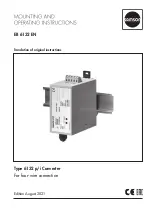
~
21
~
NOVATEK-ELECTRO
ЕТ-485
5. CONNECTION OF SEVERAL MASTER DEVICES VIA RS-485
The diagram in Figure B.2 is not limited to two networks. As it is shown in Figure B.3, a few ET-485 units with
similar redirection settings can be independently connected to
unit “b”, each one allowing to connect Modbus TCP
clients and one master client via RS-485. Herewith, Modbus networks, whereto these units are connected (e.g.
“A1”
and “A2”), are invisible to each other. Therefore the devices in these networks can have same Modbus addresses
(identifiers). I.e. an address in
“A1” network can also be used in “A2” network, but cannot be repeated in “A1” network
or “B” network.
Figure B.2
– Extension of RS-485 network
6. EXTENSION OF THE NUMBER OF CONNECTED CLIENTS
Several ET-485 units are used.
Each unit can work both in master or in slave mode via RS-485, and at the same time be set for redirection of
queries to other ET-485 unit. The order of redirection can be different: the more redirections a query goes through,
the longer is the answer delay and the more Modbus devices can be available for the client.
At consecutive “chain” redirection, as shown in Figure B.4, every new ET-485 unit is set for redirection to the
last added ET-485 unit in the chain (in the settings of which, in its turn, a new unit can be specified as the main
client). It allows increasing the number of RS-485-connected devices and simultaneously connected Modbus TCP
clients by 10 for every additional ET-485 unit.
Each of the devices can work in the slave mode via RS-485, allowing the master device from Modbus network
to address the chain section, whereto the given ET-485 unit readdresses the queries.
The client’s addressing the last unit in the chain via RS-485 or Ethernet causes sending of a query in turn
through each of ET-485 units to each Modbus network. There fore all Modbus addresses (identifiers) must be
different in all Modbus networks. Addressing the interim units in the chain accelerates query processing by means
of limitation of available devices.
In every new ET-485 unit, which is added into the chain, the answer awaiting delay from the remote server
must be chosen long enough for the query to go from the last ET-485 unit to the first one in the chain and for
the reverse answer from it.
7. ACTIVE CONNECTION TO THE CLIENT (DATA COLLECTION SERVER)
This mode is used when connection to ET-485 with specifying an IP address is difficult or impossible (ET-485
address is assigned by means of DHCP, ET-485 is connected to the Internet without static IP address etc.). The mode
allows establishing one ET-485 connection to one client, which has a static IP address and a registered host name
(herewith, each client can be simultaneously connected to many ET-485 units).





































